Motorola Droid X2 Review - A Droid X with Tegra 2
by Brian Klug on July 7, 2011 8:31 AM ESTPerformance
The X2 is powered by a 1.0 GHz Tegra 2 SoC which consists of two Cortex-A9 CPUs and NVIDIA’s ULP GeForce GPU. Anand has already detailed the architecture pretty thoroughly in our Optimus 2X review, which was the first handset to be built around Tegra 2, so if you’re interested check that out. Since then Tegra 2 has scored a lot of Motorola design wins, starting with the Atrix, the Xoom, and hopefully the unreleased Bionic.
I’ve also gone ahead and borrowed a Motorola Droid X from a friend, which I then proceeded to wipe (don’t worry, they’re used to this kind of behavior) and install the 2.3.3 update on. I then re-ran our benchmarks and updated things to give a better perspective of what the performance delta looks like right now with the X2 running 2.2.2 and the X running 2.3.3, both of which are current as of this writing.
First up are our web benchmarks, which primarily test JavaScript and page rendering. We’re still running SunSpider 0.9, though we’ll soon switch to 0.9.1 and report that alongside. JavaScript performance on Motorola’s themed browser is actually very good, and comes in nearly at the top of our charts, alongside the Optimus 2X.

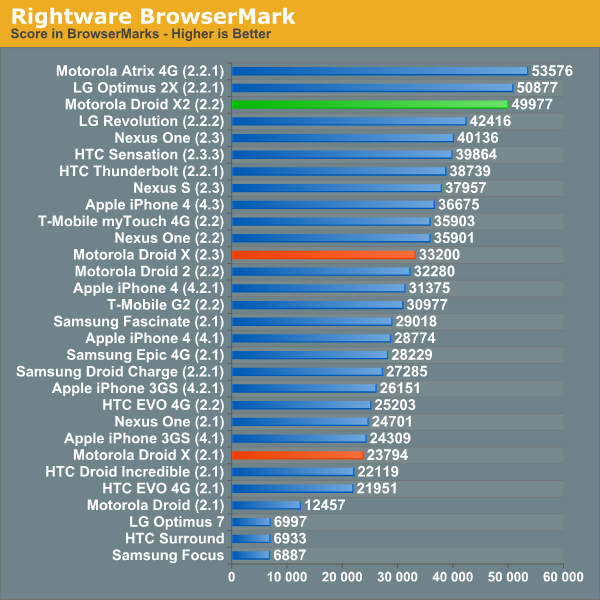
Flash is next, and here the X2 delivers very good performance that’s on par with the Optimus 2X, even though we’re dealing with a qHD screen compared to WVGA.
GLBenchmark 2.0 is a regular in our benchmarking section, and the X2 gets a run through this test as well. Performance is pretty close to the Atrix but just behind it, perhaps due to the Atrix having 1 GB of LPDDR2 compared to the X2’s less inspiring 512 MB of LPDDR2.
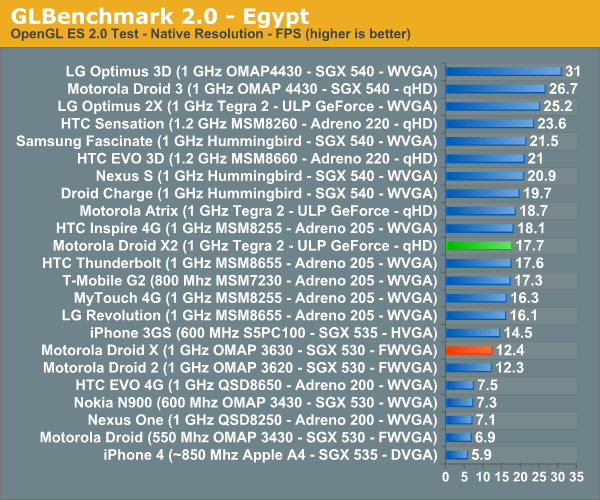
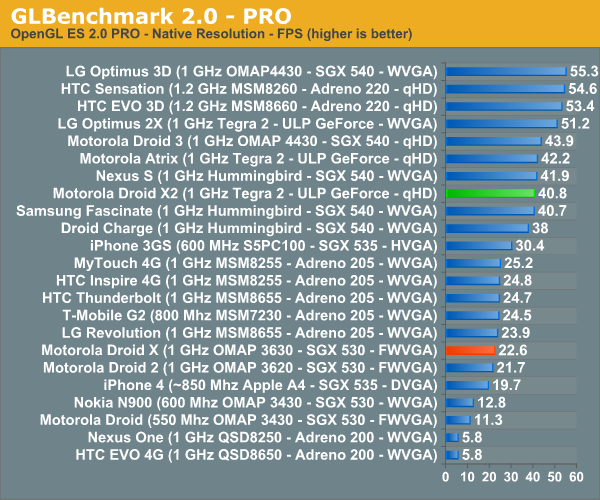
Next is BaseMark ES2.0, which is a slightly updated version of 3DMarkMobile ES2.0. Here we run at the default resolution, which is VGA, and thus get a picture without being constrained to just native resolution constantly.
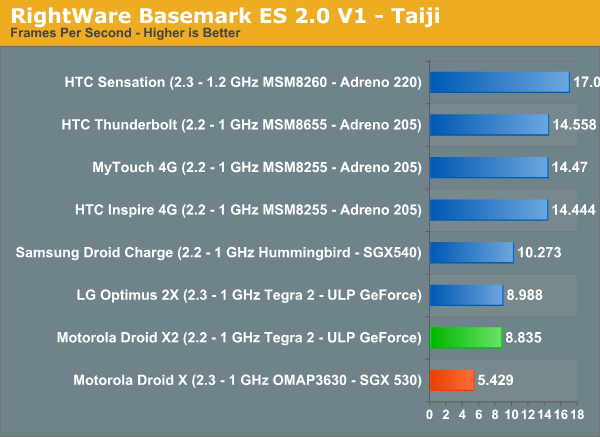
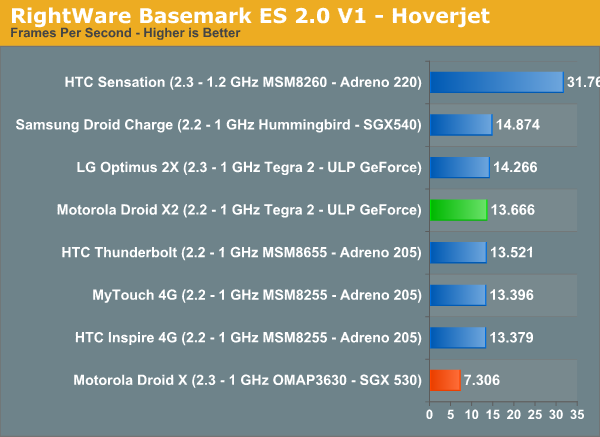
The Android port of Quake 3 is what we sort of started all of this with, and we’re still running it even if it’s starting to hit vsync in parts. The results look strange here until you realize that this is a qHD phone, not WVGA.
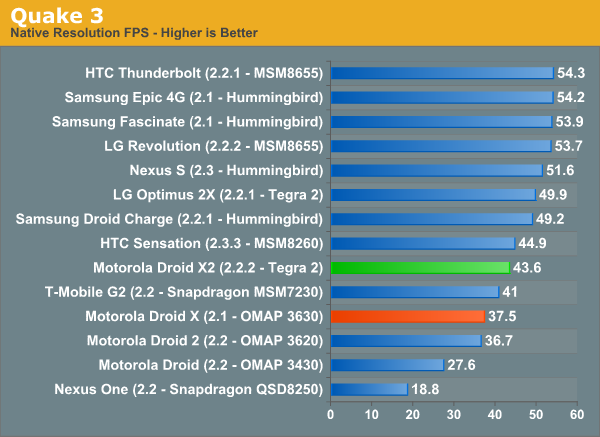
Next up is Linpack, which added a multi-threaded version of the benchmark earlier this week. I’ve run it on all the dual core devices I could get my hands on.
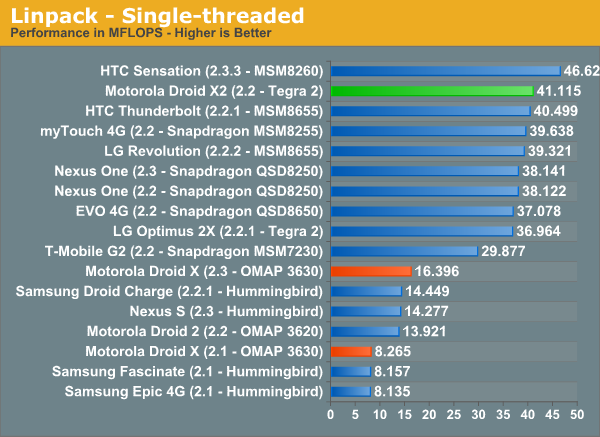
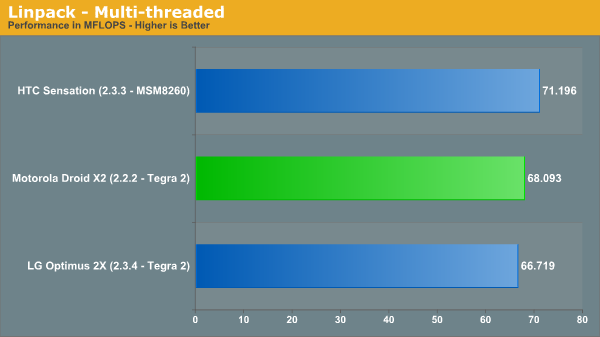
Last up is Quadrant which will be depreciated pretty soon as it’s at the framerate cap in its 3D tests, has overall little to no documentation for most of the subtests, and generally is woefully out of date. The X2 does extremely well in the I/O test thanks to it using EXT3 for most partitions.
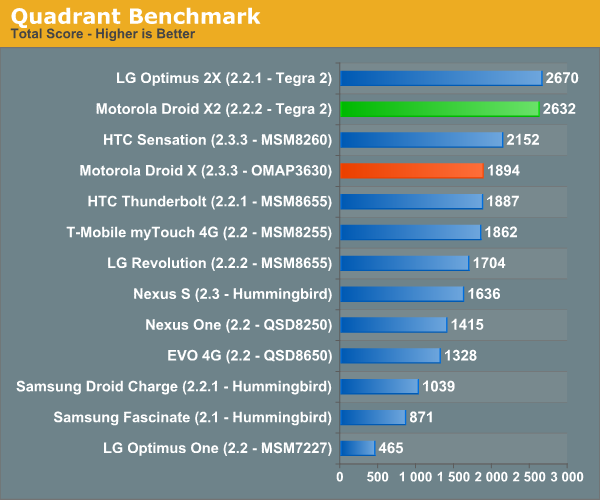
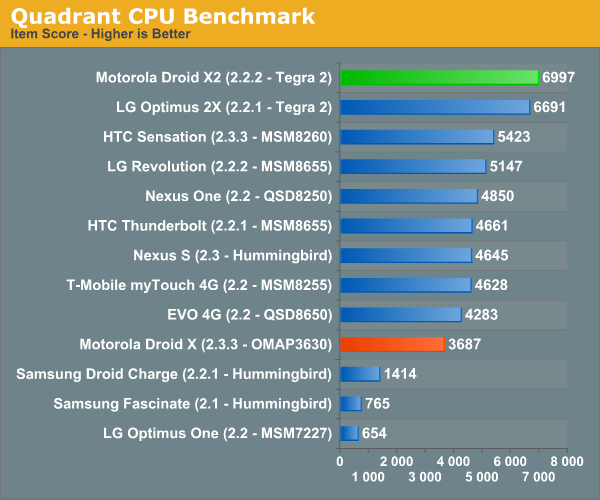
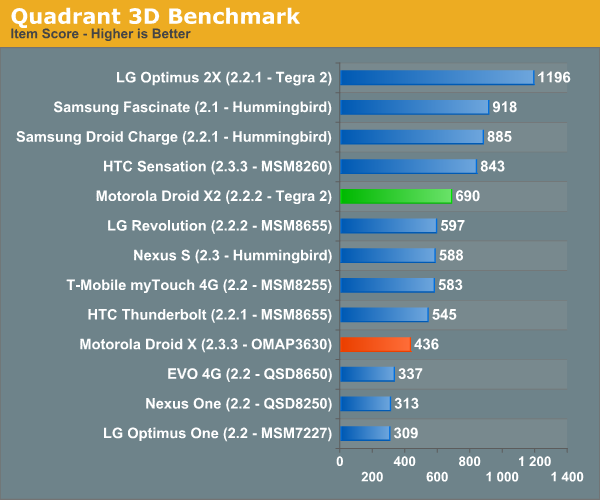
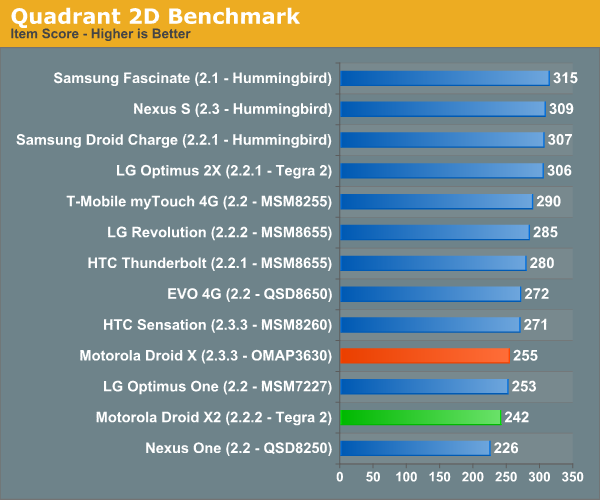
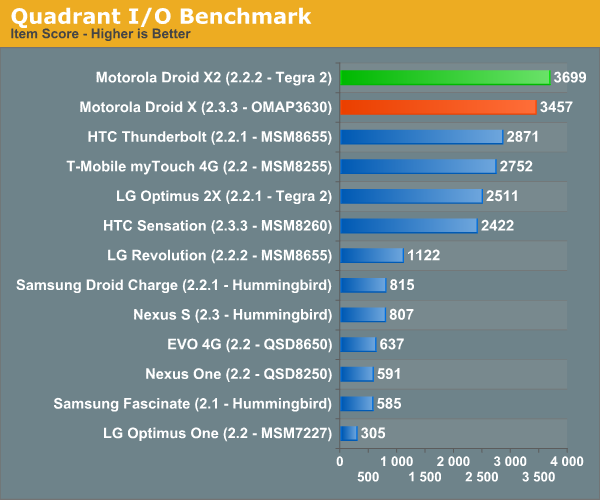
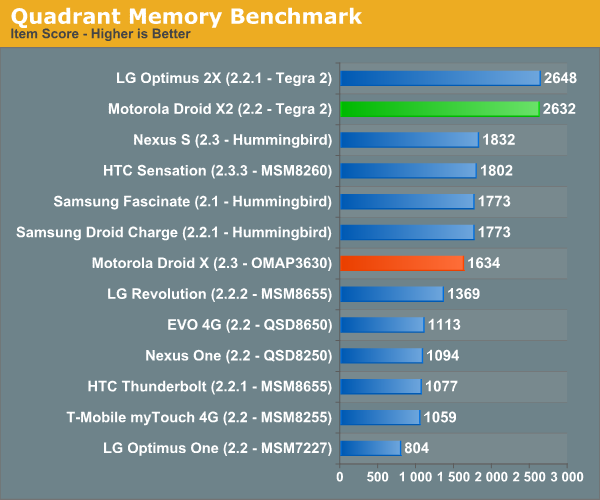










72 Comments
View All Comments
anandatar - Thursday, July 7, 2011 - link
So yeah, I know, Anandtech is a US blog.Still I'm surprised there is no comparison to the Galaxy S 2 - I was already surprised before by this but nothing has changed.
The main reason is because ALL the phones in the comparison look pale when compared with the S2.
It's (much) faster than any of the Tegra2 based devices.
It has more ram.
It's (much) lighter (there's no xperia either)
It's (much) thinner (there's no xperia either)
it's camera still picture is second to the N8 only
it's camera video recordings are above average (not blowing others out of the water tho - in 1080p it's zoomed and focusing is slower - in 720p its awesome)
it's battery life is (much) improved too
in fact, on the paper, only the resolution (800x480) is lower than the other phones (that sometimes have qHD)
Not only that, but it's also the first phone I'd use instead of an iPhone - it's that much better that it makes sense to switch. But I wouldnt settle for less.
jmcb - Thursday, July 7, 2011 - link
Glad you like the GS2 so much....If you know all this, why do you need to see a comparison? Check other sites, they do compare the GS2 with other phones...Imma help you out.... phonearena is one site that does. phonedog is another...
NeoteriX - Thursday, July 7, 2011 - link
You mentioned in your HTC Sensation review that with a little digging, you were able to come up with the camera sensor used there -- "Samsung’s 8 MP S5K3H1GX 1/3.2” 3264x2488 CMOS sensor with 1.4 µm square pixels "Though the sensor isn't the only thing as you mentioned (lens, etc.), it's useful to compare stated sensitivities, pixel sizes, etc. across the different current phones as well as generationally. I still feel like the gold standard is the iPhone 4 with its 1.75 µm pixel sites and BSI Omnivision sensor.
Do you have this information for the Droid X and X2? How does one generally determine this? I'd love to be able to figure it out for my Evo 3D.
munky - Thursday, July 7, 2011 - link
Iphone4 is by no means the gold standard. Also, there's plenty of variables affecting sensor performance which wouldn't be obvious just by looking at pixel pitch, not to mention how the image processing algorithms affect the final outcome. Unless you suggest AT start evaluating sensors with RAW data a la dxomark, I'd much rather they focus on comparing actual photos as opposed to numerical specs.NeoteriX - Thursday, July 7, 2011 - link
I agree that specs aren't the whole picture, but I do think it provides useful insight to augment the results one sees in practical testing -- things like being able to tell how much of the improvement is image processing, what generation the sensor is and recently of development, and seeing if improving the image quality/sensors used is actually a priority for certain manufacturers. More information never hurts and it helps understand the story -- for example, when digital cameras were undergoing the megapixel race one or two years ago, it was clear that low light quality was degrading and pixel sites helped explain that story.At any rate, I'm no expert on the state of cellphone cameras, but I will respectfully disagree with you on the iPhone 4 -- no other non-camera-phone smartphone (i.e., the Sony/Nokia/etc. type phones with real digital camera level optics and sensors built in, xenon-flashes the whole 9 yards) *I've seen* has the kind of low-light sensitivity and all-around flexibility of the iPhone 4.
It's likely a combination of the relatively large sensor sites, the large fixed aperture of the lens, the BSI CMOS design, and good image processing, but Android mfrs still have their work cut out for them over a year after the iPhone 4 release -- I'd be interested in hearing what other phone is better in low-light and all-around capability, because I certainly haven't seen it.
Exodite - Thursday, July 7, 2011 - link
The new Xperia series (arc/neo/pro/play) seems a good fit, especially considering that the iPhone 5 is slated to use the same sensor as those handsets.Anyway the criteria you use for comparison are rather humorous, as it reads like the iPhone 4 having the best camera - as long as you disregard those that are better?
HTC is generally known to ship shitty cameras but I'd say both foo, bar, beep and bloop - to name those at the top of my mind - offer some excellent solutions for those who want decent images from their smartphones.
(As a side note to Anandtech - your spam filter sucks! Horribly.)
Exodite - Thursday, July 7, 2011 - link
Feel free to replace foo, bar, beep and bloop with the names of big smartphone manufacturers that aren't HTC.I would do it myself, if that wouldn't mean getting caught in the spam filter.
NeoteriX - Thursday, July 7, 2011 - link
That's fair although I wouldn't call my criteria bogus ;)The vast majority of cell/smartphones are those built around sensor/lens/IC SOCs primarily built for mobile applications, they feature LED-based flashes--in essence, they are known to be significant compromises in the world of digital imaging because they are, in other words, phones first, cameras second.
Then, there is a small minority of cell phones that are essentially cameras with phones attached to them -- SonyEricsson C-902, Nokia N82, etc. that feature sensors and lenses pulled from traditional cameras, but with phone functionality -- we're talking about large sensors, camera glass, and xenon flashes intended for P&S digital camera applications and not mobile.
I've heard good things about the new Xperia Arc with the Exmor R BSI sensor, but it hasn't been released in the US yet and neither has the iPhone 5... thus my position that the iPhone 4 leads the pack.
Exodite - Thursday, July 7, 2011 - link
I would say my arc does decent pictures, though perhaps I'm spoiled by the fact that my better half uses a Nokia N8. Color accuracy is good but the focus area is unfortunately very narrow which makes the pictures less good than they could be.The Samsung Galaxy S2 is arguably better, end results considered.
Anyway, I hope the iPhone 5 does end up using the same sensor as the Xperia line as it'd be interesting to see what a different hard/software solution would do with the same sensor.
Then there's stuff like the Motorola Milestone which also have a great camera, considering.
Would an N8 qualify, or is that too a camera first?
Because from my standpoint I can see something like the Altek Leo being a camera first and phone second but I'd still consider anything in a normal housing to be a phone first.
munky - Thursday, July 7, 2011 - link
Have you seen the photos taken with the Nokia N8? They are cleaner that those from iphone4, not to mention more natural looking due to lack of over-sharpening and over-saturation. The iphone4 may be good compared to a crappy phonecam, but it is definitely not the best.